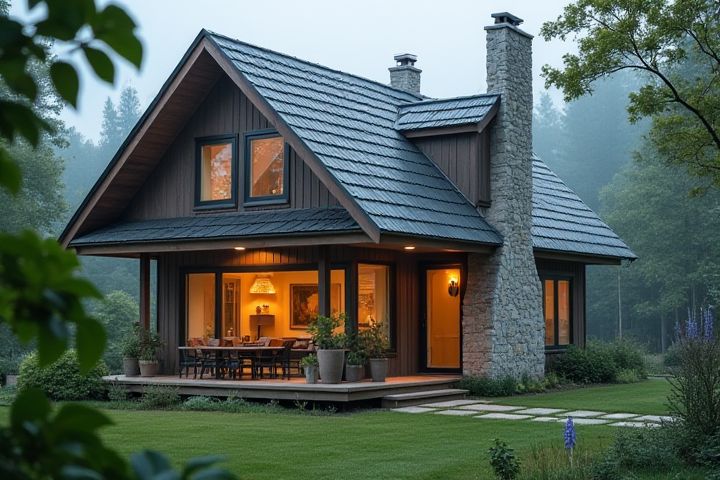
To cool your house efficiently, start by optimizing your home's insulation and sealing any gaps to prevent cool air from escaping. Installing energy-efficient windows, such as double or triple-pane models, can significantly reduce heat entry while allowing natural light. Utilize ceiling fans to circulate air effectively; running them counterclockwise can create a wind-chill effect, making the space feel cooler. Consider investing in a programmable thermostat that regulates temperature according to your schedule, minimizing energy usage when you're not home. Lastly, strategically using shades or outdoor awnings can block direct sunlight, keeping your interiors comfortably cool throughout the day.
How To Cool A House Efficiently
Use ceiling fans
Ceiling fans can reduce reliance on air conditioning by providing a wind-chill effect that makes you feel cooler, allowing you to raise your thermostat setting by about 4degF to 7degF without compromising comfort. By operating ceiling fans in a counterclockwise direction during warm months, you circulate cool air throughout the room more effectively. Make sure to upgrade to energy-efficient models that use approximately 50% less energy than standard fans, which can help decrease your electricity bills. Regular maintenance, like cleaning the blades and checking the motor, will ensure optimal performance, prolonging the lifespan of your ceiling fans.
Optimize window coverings
Optimize your window coverings to enhance cooling efficiency by selecting reflective blinds or shades that block heat while allowing natural light to filter in. Consider installing insulated curtains, which can reduce indoor temperatures by up to 25% during peak heat hours. Utilize light-colored window treatments that reflect sunlight instead of absorbing it, helping maintain a cooler home environment. During the hottest parts of the day, keep windows covered to minimize solar heat gain and lower your reliance on air conditioning systems.
Install reflective roofing
Installing reflective roofing can significantly reduce your home's cooling costs by reflecting solar radiation away from the house. Research indicates that reflective roofs can decrease indoor temperatures by up to 10 to 15 degrees Fahrenheit, resulting in lower reliance on air conditioning systems. This energy-efficient solution not only prolongs the lifespan of your roof but also helps minimize the urban heat island effect, making it a sustainable choice. By choosing materials with high solar reflectance, you can enhance your home's energy efficiency while contributing to a cooler environment.
Insulate properly
Proper insulation is crucial for keeping your house cool, as it minimizes heat gain during hot months. Aim for a minimum R-value of 30 in your attic and R-value of 13 in your walls to enhance thermal resistance. Consider materials such as spray foam, fiberglass batts, or cellulose, which can significantly reduce your energy costs by up to 20%. Ensuring that windows and doors are properly weather-stripped also aids in preventing air leaks, maintaining cooler indoor temperatures.
Utilize cross-ventilation
To cool a house efficiently, utilize cross-ventilation by strategically opening windows and doors on opposite sides. This allows for a natural airflow, enabling cooler air to enter while warmer air exits. Positioning fans near these openings can enhance the circulation and expedite the cooling process. By implementing this method during the coolest parts of the day, such as early morning or late evening, you can significantly reduce indoor temperatures without relying heavily on air conditioning.
Plant shade trees
Planting shade trees around your house is an effective way to naturally cool your home and reduce energy costs. Strategically positioning deciduous trees on the south and west sides will block harsh sunlight during hot summer months while allowing sunlight to warm your home during winter after their leaves fall. These trees not only provide shade but also improve air quality and enhance your property's aesthetic appeal. By incorporating native species, you can further support local wildlife while maximizing your home's comfort and sustainability.
Use energy-efficient light bulbs
Using energy-efficient light bulbs, such as LED or CFL options, can significantly reduce heat output in your home. These bulbs convert a higher percentage of energy into light rather than heat, helping to maintain a cooler indoor temperature. By replacing traditional incandescent bulbs with energy-efficient alternatives, you can lower your energy bills while contributing to a more sustainable environment. Focus on installing these bulbs in high-use areas, as they not only provide bright illumination but also enhance overall energy efficiency.
Seal air leaks
Sealing air leaks is a crucial step in efficiently cooling your house, as it prevents warm outdoor air from infiltrating your living space and ensures maximum efficiency of your cooling system. Inspect areas around windows, doors, and vents for gaps, and use weatherstripping or caulk to fill them, effectively reducing the heat exchange between your home and the outside. Consider using foam sealant for larger cracks or holes, especially in attics and crawl spaces, where significant air loss can occur. By prioritizing air leak sealing, you not only enhance indoor comfort but also improve energy efficiency, lowering your cooling costs over time.
Schedule regular HVAC maintenance
Regular HVAC maintenance is essential for cooling your house efficiently. Schedule routine inspections for your system, which typically include cleaning and replacing filters, checking refrigerant levels, and inspecting ductwork. This proactive approach not only enhances your system's performance but also extends its lifespan, reducing the risk of unexpected breakdowns. By ensuring your air conditioning unit operates at peak efficiency, you can enjoy a consistently comfortable indoor climate while lowering your energy bills.
Consider programmable thermostats
Programmable thermostats can reduce your energy consumption by up to 10-15% annually, optimizing your cooling system based on your daily schedule. By setting different temperatures for day and night, you maintain comfort while minimizing wasted energy. You can program these devices to raise the temperature while you're away and cool down shortly before you return, ensuring efficiency. Additionally, many models offer remote access via smartphone apps, allowing you to adjust settings in real-time, even when you're not home.
